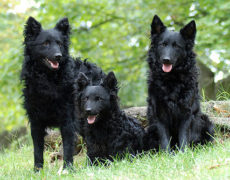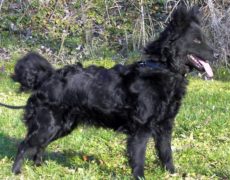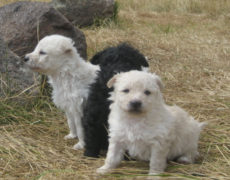Mudi
The Mudi, a herding breed of Hungarian origin, is a popular show and sports dog because of its flexible and versatile nature. Some of its common physical traits include a wedge-shaped head, pointed nose, erect ears and a bob or long tail. These dogs, related to the two other Hungarian breeds, Pumi and Puli, got separated from them during the 1930s.
Mudi Pictures
- Canis Ovilis Fenyesi
- Hungarian Mudi
- Mudi Dog Breed
- Mudi Dog
- Mudi Dogs
- Mudi Images
- Mudi Pictures
- Mudi Puppies
- Mudi Puppy
- Mudi
Quick Information
| Other Names | Hungarian Mudi, Canis Ovilis Fenyesi |
| Pronunciation | Moody |
| Coat | Has a dense coat ranging from wavy to curly along with short hair covering its face and legs |
| Color | Black, brown, gray, white, red, fawn, cifra ( black and gray marbling) and ash |
| Type | Purebred |
| Group | Herding dogs, Rare dog breeds |
| Lifespan | 13 to 14 years |
| Size | Medium |
| Height | 15 to 19 inches |
| Weight | 18 to 29 pounds |
| Litter size | 5 to 10 puppies |
| Temperament | Protective, alert, active, smart and keen |
| Good with Children | Yes ( particularly older ones) |
| Climate Compatibility | Preferably warm climate |
| Barking | High-pitched loud bark |
| Shedding | Average |
| Hypoallergenic | No |
| Competitive Registration Qualification/ Information | ACA, APRI, AKC/FSS, ACR, CKC, DRA, NAPR, NKC, FCI |
| Country | Hungary |
Jumping Mudi (Hungarian Shepherd Dog Video)
History
Though there is not much detail regarding the history of the Mudi Dog, its origin can be traced back in between the 15th and 18th centuries. The breed is called Canis Ovilis Fenyesi in Latin, attaining its name from its founder Dr. Dezso Fenyes, who discovered it as a breed in the year 1936, in Hungary . Another nickname of the Mudi in its place of origin is the Driver Dog.
Some theories also state that the Mudis may have been descendants of the Spitz and herding breed crosses.
After attaining recognition, their numbers fell drastically as most of them were victims of the Second World War. With the few of the left, the breed was developed again and also attained recognition by the FCI and UKC in 1966 and 2006 respectively. Though the AKC recognizes them as herding dogs, they have not obtained full recognition from them, owing to their small numbers. However, the Mudis still belong to the American Kennel Club Foundation Stock Service, eligible to take part in the performance and companion sports of the AKC.
Temperament
The Mudi with its herding skills emerges as a capable farm dog, excelling in hunting as well as exterminating rodents.
Being courageous and powerful, they have an increasingly alert nature, going to any extent to protect its family. They even possess a loud, high-pitched bark, notifying its master the moment an intruder steps on his property. These traits thereby make it a useful watchdog.
Besides its alert nature, it also has a loving and affectionate disposition, bonding extremely well with its family members and following his master everywhere, thus being an excellent companion dog.
It gets along well with children, preferably older ones, who can handle it with great maturity.
They are dog-friendly and may also share a good rapport with other pets, especially when brought up with them or socialized to mingle with them in an amicable way.
Having a playful and agile nature they are eligible to compete in a whole lot of events including agility sports, rally obedience, tracking, Flyball, herding events, showmanship, and Schutzhund.
Care
Exercise
These active dogs need a sufficient amount of exercise on a daily basis which may include a long walk, brisk jog and plenty of play time in a garden or fenced yard. It would thrive well in an apartment provided there is ample space to play and burn its energy. Introducing a host of indoor games like hide and seek, fetching a ball or even taking short walks in the hallways would be sufficient.
Grooming
The Mudi needs weekly brushing to remove the dead hairs. Occasional bathing would help in keeping it clean. Other grooming needs include nail trimming, brushing its teeth and also keeping its eyes and ears clean.
Health Problems
The Mudi is considered to be a healthy breed. However, there have been frequent occasions of hip dysplasia.
Training
Being an exceedingly intelligent breed, the Hungarian Mudi has a fast learning capacity and would be great to train for a host of activities like doing tricks, participating in a host of events and as a companion as well as therapy dogs.
Stranger anxiety: Since it is not at all cooperative in dealing with strangers, owners should teach Mudi puppies to differentiate a threat from a pleasant experience. Moreover, it should get to interact more with regular visitors to your house so that it gradually forms a strong rapport with them.
Obedience: To keep its barking instinct under check teach your puppy how to stop on hearing the command “No,” or “Pause.” Whenever you find your dog barking without any reason, distract it by making a loud noise either by using a bell or clapping your hands, also utter the word no in a clear and firm tone. If it discontinues its activity and sits down, then reward it with praises and a treat.
Destructive habits: To get rid of its digging habit engages it with a lot of exciting games and activities so that it may not indulge in such destructive behavior.
Leash training: This is crucial keeping in mind your Mudi’s herding and chasing extinct.
Feeding
Feed these high-energy dogs with high-quality dry dog food alongside other nutrients.
Interesting Facts
- Two Mudi dogs in Canada had a life span as long as 17.5 years.
- It is an active herding dog in Hungary even at present, being with flocks containing as many as 500 sheep.















